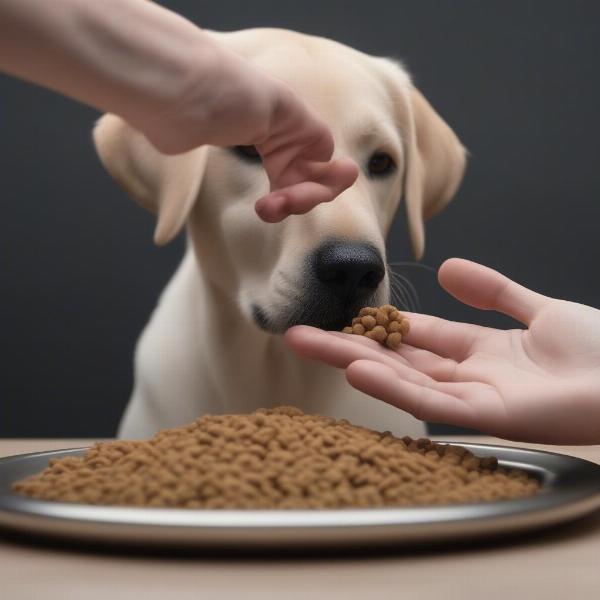If your dog inhales their food like it’s the last meal on earth, you’re not alone. Many dog owners struggle with a speedy eater. This habit can lead to choking, vomiting, and even a serious condition called bloat. This article will explore effective strategies on how to slow a dog down while eating, ensuring they enjoy their meals at a healthier pace.
Understanding Why Dogs Eat Too Fast
Several factors can contribute to fast eating in dogs. Competition, especially in multi-dog households, can trigger a “scarcity mindset.” Some dogs simply have a naturally voracious appetite. Past experiences of food insecurity can also play a role. Anxiety or stress can also manifest as rapid eating. Identifying the underlying cause can help tailor your approach to slowing down your furry friend’s mealtimes.
Effective Methods to Slow Down a Dog’s Eating
There are various methods you can employ to encourage slower eating. Here’s a breakdown of some of the most effective strategies:
- Food Puzzles and Slow Feeders: These interactive bowls force your dog to work for their food, engaging their minds and slowing down their eating pace. They come in various designs, from mazes to puzzles, offering different levels of challenge.
- Scatter Feeding: Spreading kibble across a large area, like your lawn or a designated room, encourages foraging behavior and naturally slows down the eating process. This method is particularly beneficial for dogs with a high prey drive.
- Hand Feeding: While time-consuming, hand feeding can be a great way to bond with your dog and control their eating speed. This method also allows you to monitor for any potential choking hazards.
- Adding Large, Safe Objects to the Bowl: Placing a large, inedible object like a tennis ball (ensure it’s too big to swallow) in the food bowl can obstruct your dog’s access to large amounts of food at once, forcing them to eat around it.
- Multiple Small Meals: Instead of one large meal, divide your dog’s daily food allowance into several smaller portions throughout the day. This can help prevent overeating and reduce the urge to gulp down food quickly.
Choosing the Right Method for Your Dog
The best method for slowing down your dog’s eating will depend on their individual personality, breed, and the underlying cause of their fast eating. Experiment with different techniques to find what works best for your furry friend. If your dog exhibits signs of anxiety or stress around mealtimes, consult with a veterinarian or a certified dog trainer for personalized guidance.
When to Seek Professional Help
While fast eating is often a manageable issue, there are instances where professional help is necessary. If your dog consistently vomits or regurgitates after meals, experiences difficulty breathing, or shows signs of abdominal distension, seek immediate veterinary attention. These could be symptoms of bloat, a life-threatening condition.
Maintaining Healthy Eating Habits
Once you’ve implemented strategies to slow down your dog’s eating, consistency is key. Maintain the chosen method for every meal to reinforce the new eating habits. Regularly monitor your dog’s eating behavior and adjust your approach as needed.
 Hand feeding a dog
Hand feeding a dog
Conclusion
Slowing down a dog’s eating is crucial for their overall health and well-being. By understanding the reasons behind fast eating and implementing appropriate strategies, you can help your canine companion enjoy mealtimes at a safer and more enjoyable pace. Remember to be patient and consistent, and don’t hesitate to seek professional help if needed. Implementing these strategies can significantly improve your dog’s digestive health and prevent potential complications associated with fast eating.
FAQ
- Is it normal for dogs to eat fast? While some dogs naturally eat faster than others, excessively fast eating can be problematic.
- What are the signs of bloat? Signs of bloat include restlessness, pacing, excessive drooling, abdominal distension, and attempts to vomit without success.
- Can a slow feeder harm my dog? Slow feeders are generally safe, but choose one appropriate for your dog’s size and breed to avoid frustration.
- How long does it take for a dog to adjust to a slow feeder? It can take a few days to a few weeks for a dog to adjust to a slow feeder.
- What if my dog still eats too fast despite using a slow feeder? Try a different type of slow feeder or combine it with another method, like scatter feeding.
- Should I be concerned if my dog eats slowly sometimes? Occasional slow eating isn’t usually a cause for concern, but persistent changes in appetite should be checked by a vet.
- Can fast eating be a sign of a medical condition? While usually behavioral, fast eating can sometimes indicate underlying medical issues, so consult with your vet if you’re concerned.
ILM Dog is a leading international dog website dedicated to providing expert advice on all aspects of dog care and wellbeing. From breed selection and puppy care to senior dog health and training, we offer a wealth of information to help you navigate every stage of your dog’s life. We specialize in providing practical, trustworthy guidance on dog breeds, health, training, nutrition, grooming, and much more. For expert advice tailored to your specific needs, contact us via email at [email protected] or by phone at +44 20-3965-8624. ILM Dog is here to support you and your furry friend every step of the way.